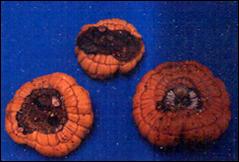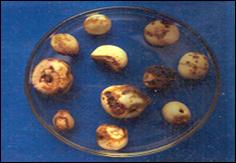GLADIOLUS (Gladiolus spp)
Iridaceae |
Varieties
Tropic Sea, White Prosperity, Priscilla, Summer Sunshine, Pusa Swarnima, Jackson Ville Gold, KKL.1, Archana, Basant Bahar, Indrani, Kalima, Kohra, Aarti, Arka Kesar, Darshan, Dhiraj, Agnirekha, Archana, Bindiya, Shree Ganesh
Climate: Subtropical and temperate climatic conditions are suitable. The crop performs well under a temperature range of 27 - 30°C. It requires full exposure to sunlight and performs well with long day conditions of 12 to 14 hour photoperiod.
Soil: Well drained sandy loam soil rich in organic matter with pH of 6 to 7.
Season
This crop requires minimum 10 hours of sunlight to over come blindness. So season should be adjusted or light substitution should be given.
Propagation:
Commercial propagation is through corms. Cold storage of corms at 3 to 7°C for 3 months or treatment with Ethrel (1000ppm) or GA3 (100ppm) or Thiourea (500 ppm) is adopted for breaking corm dormancy.
Field preparation and planting:
Beds of size 6 x 2 m are prepared and corms are planted at a depth of 5 cm adopting a spacing of 40 x 25 cm (88,888 plants/ha) or 25 x 25 cm (1,60,000 plants/ha).
Planting season:
October for plains and March-April for hills.
Planting system
Ridges and furrows system is adopted.
Irrigation: Irrigate at 7-10 day intervals in sandy soils and at less frequent intervals in heavy soils. Irrigation should be withheld at least 4-6 weeks before lifting of corms.
Nutrition: 120 kg N, 150 kg P2O5 and 150 kg K2O per hectare is recommended, of which 60 kg N and entire dose of P2O5 and K2O is applied as basal dose. The remaining N is given in two split doses, 30 and 60 days after planting.
Manuring
Basal
N 60 kg/ha, P 150 kg/ha, K150 kg/ha.
Top dressing
N alone is given @ 30 kg/ha during 4 leaf stage as foliar spray and 30 kg/ha during bud stage as soil application.
Aftercultivation
After the corms have sprouted well, watering should be done, if necessary. When the shoots are about 20 cm high they are covered by heaping the soil up to a height of 10 to 15 cm. This enables the plants to grow erect despite high winds and rains and suppresses weed growth. Earthing up the soil is a must in case of light soils. In case where spikes grow longer or stems are not strong enough to bear the lodging or mild stroke of wind, they are supported with about 1.5 meters strong stakes. Strings instead of stakes may be used at the time of the appearance of the spikes. Strings are stretched between the stakes along the row to provide easy and adequate support.
Plant Protection
1. Before storage, corms are dipped in hot water at 40 - 45oC + fungicide (captan or thiram 2 g/lit) to control Nematode and fungal disease.
2. Thrips can be controlled by methyl demeton 25 EC 2 ml/lit. or dimethoate 30 EC @ 2 ml/lit.
3. Semilooper and Helicoverpa can be controlled by methyl demoton .
Leaf spot
Spray Carbendazim or Mancozeb 2 g/lit to control leaf spot.
Wilt
Drenching of Bavistin (0.2%) at fornight intervals controls the wilt disease.
Blight disease
Blight disease can be controlled by spraying Mancozeb @ 0.2 %
|

|

|
Storage rot |
|
Storage rot
Spraying of Benomyl (0.2%) controls the storage rot
Season of flowering and Harvesting
When first bud shows the colour of the variety harvesting is started.
Fluoride injury
Leaf scorch of gladioli is observed due to the presence of fluorine compounds in the atmosphere which got accumulated on the tips of leaves. The injury is associated with heavy application of super phosphate.
Special practices:
Staking:Large flowered varieties should be staked to avoid lodging.
Plant protection
Pests
Thrips:Spray Dimethoate 30 EC @ 2ml/l or Fenitrothion 50 EC @ 2ml/l or Malathion 50 EC @ 2ml/l
Semi looper and Helicoverpa: Methyl Demeton 25 EC or Dimethoate 30 EC @ 2ml/l
Diseases
Leaf spot: Foliar application of Carbendazim @ 1g/l or Mancozeb @ 2g/l
Core or spongy rot: Foliar application of Benomyl @ 1 kg/ha
Bacterial scab blight and spots: Dipping the corms in 1:100 Mercuric chloride solution for 12 hours before planting.
Harvesting of spikes:
Gladiolus takes 110-120 days to produce spikes. While harvesting, at least four basal leaves should be retained on the plant to ensure proper development of corms and cormels.
Post harvest treatment and Grading
Soak the stem in water to avoid wilting and lodging of stem and flower. Based on stem length and number of florets, the spikes are grouped into A, B, C, D grades.
Yield
2.0 - 2.5 lakh flower stalks/ha/crop. |





